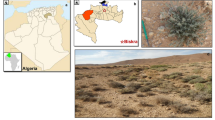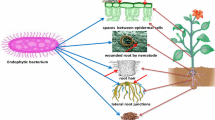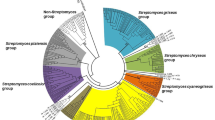Abstract
Arnica montana L. is a medical plant of the Asteraceae family and grows preferably on nutrient poor soils in mountainous environments. Such surroundings are known to make plants dependent on symbiosis with other organisms. Up to now only arbuscular mycorrhizal fungi were found to act as endophytic symbiosis partners for A. montana. Here we identified five Streptomyces strains, microorganisms also known to occur as endophytes in plants and to produce a huge variety of active secondary metabolites, as inhabitants of A. montana. The secondary metabolite spectrum of these strains does not contain sesquiterpene lactones, but consists of the glutarimide antibiotics cycloheximide and actiphenol as well as the diketopiperazines cyclo-prolyl-valyl, cyclo-prolyl-isoleucyl, cyclo-prolyl-leucyl and cyclo-prolyl-phenylalanyl. Notably, genome analysis of one strain was performed and indicated a huge genome size with a high number of natural products gene clusters among which genes for cycloheximide production were detected. Only weak activity against the Gram-positive bacterium Staphylococcus aureus was revealed, but the extracts showed a marked cytotoxic activity as well as an antifungal activity against Candida parapsilosis and Fusarium verticillioides. Altogether, our results provide evidence that A. montana and its endophytic Streptomyces benefit from each other by completing their protection against competitors and pathogens and by exchanging plant growth promoting signals with nutrients.




Similar content being viewed by others
Abbreviations
- Act D:
-
Actinomycin D
- ANOVA:
-
Analysis of variance
- EUCAST:
-
European Committee on Antimicrobial Susceptibility Testing
- ESCOP:
-
European Scientific Cooperative on Phytotherapy
- HRESI:
-
High-resolution electrospray ionization
- NIST:
-
National Institute of Standards and Technology
- UPLC:
-
Ultra performance liquid chromatography
References
Ball P (2000) Quinolone generations: natural history or natural selection? J Antimicrob Chemother 46:17–24
Bérdy J (2005) Bioactive microbial metabolites. J Antibiot (Tokyo) 58:1–26
Bitzer J (2005) Isolierung und Strukturaufklärung neuer Naturstoffe aus Bakterien und endophytischen Pilzen durch chemisches Screening. Disseration, University of Göttingen
Brown DW, Butchko RAE, Proctor RH (2006) Fusarium genomic resources: tools to limit crop diseases and mycotoxin contamination. Mycopathologia 162:191–199
Cabrera GM, Butler M, Rodriguez MA, Godeas A, Haddad R, Eberlin MN (2006) A sorbicillinoid urea from an intertidal Paecilomyces marquandii. J Nat Prod 69:1806–1808. doi:10.1021/np060315d
Castillo UF, Browne L, Strobel G, Hess WM, Ezra S, Pacheco G, Ezra D (2007) Biologically active endophytic streptomycetes from Nothofagus spp. and other plants in Patagonia. Microb Ecol 53:12–19. doi:10.1007/s00248-006-9129-6
Coombs JT, Franco CMM (2003) Isolation and identification of actinobacteria from surface-sterilized wheat roots. Appl Environ Microbiol 69:5603–5608. doi:10.1128/AEM.69.9.5603-5608.2003
Demain AL (1999) Pharmaceutically active secondary metabolites of microorganisms. Appl Microbiol Biotechnol 52:455–463
Diminic J, Starcevic A, Lisfi M, Baranasic D, Gacesa R, Hranueli D, Long PF, Cullum J, Zucko J (2014) Evolutionary concepts in natural products discovery: what Actinomycetes have taught us. J Ind Microbiol Biotechnol 41:211–217. doi:10.1007/s10295-013-1337-8
Effendi H (2004) Isolation and structure elucidation of bioactive secondary metabolites of sponge-derived fungi collected from the Mediterranean sea (Italy) and Bali sea (Indonesia). Dissertation, University of Düsseldorf
ESCOP (2003) ESCOP monographs: the scientific foundation for herbal medicinal products, 2nd edn. Thieme, Stuttgart
Fdhila F, Vázquez V, Sánchez JL, Riguera R (2003) dd-diketopiperazines: antibiotics active against Vibrio anguillarum isolated from marine bacteria associated with cultures of Pecten maximus. J Nat Prod 66:1299–1301. doi:10.1021/np030233e
Fukuda T, Matsumoto A, Takahashi Y, Tomoda H, Omura S (2005) Phenatic acids A and B, new potentiators of antifungal miconazole activity produced by Streptomyces sp. K03-0132. J Antibiot (Tokyo) 58:252–259. doi:10.1038/ja.2005.29
García-Piñeres AJ, Castro V, Mora G, Schmidt TJ, Strunck E, Pahl HL, Merfort I (2001) Cysteine 38 in p65/NF-kappaB plays a crucial role in DNA binding inhibition by sesquiterpene lactones. J Biol Chem 276:39713–39720. doi:10.1074/jbc.M101985200
Highet RJ, Prelog V (1959) Stoffwechselprodukte von Actinomyceten. 18. Mitteilung. Actiphenol. Helv Chim Acta 42:1523–1526. doi:10.1002/hlca.19590420514
Holden MT, Ram Chhabra S, de Nys R et al (1999) Quorum-sensing cross talk: isolation and chemical characterization of cyclic dipeptides from Pseudomonas aeruginosa and other gram-negative bacteria. Mol Microbiol 33:1254–1266
Ji X, Zhong Z, Xue S, Meng S, He W, Gao R, Li Y, Li Z (2010) Synthesis and antiviral activities of synthetic glutarimide derivatives. Chem Pharm Bull (Tokyo) 58:1436–1441
Jiménez-Esquilín AE, Roane TM (2005) Antifungal activities of actinomycete strains associated with high-altitude sagebrush rhizosphere. J Ind Microbiol Biotechnol 32:378–381. doi:10.1007/s10295-005-0007-x
Jurkiewicz A, Ryszka P, Anielska T, Waligórski P, Białońska D, Góralska K, Tsimilli-Michael M, Turnau K (2010) Optimization of culture conditions of Arnica montana L.: effects of mycorrhizal fungi and competing plants. Mycorrhiza 20:293–306. doi:10.1007/s00572-009-0280-z
Katoh K, Misawa K, Kuma K, Miyata T (2002) MAFFT: a novel method for rapid multiple sequence alignment based on fast Fourier transform. Nucleic Acids Res 30:3059–3066. doi:10.1093/nar/gkf436
Kearse M, Moir R, Wilson A et al (2012) Geneious basic: an integrated and extendable desktop software platform for the organization and analysis of sequence data. Bioinformatics 28:1647–1649. doi:10.1093/bioinformatics/bts199
Kieser T, Bibb MJ, Buttner MJ, Chater KF, Hopwood DA (2000) Practical Streptomyces genetics. The John Innes Foundation, Norwich
Klose KE (2006) Increased chatter: cyclic dipeptides as molecules of chemical communication in Vibrio spp. J Bacteriol 188:2025–2026. doi:10.1128/JB.188.6.2025-2026.2006
Krause L, McHardy AC, Nattkemper TW, Pühler A, Stoye J, Meyer F (2007) GISMO-gene identification using a support vector machine for ORF classification. Nucleic Acids Res 35:540–549. doi:10.1093/nar/gkl1083
Lakhvich FA, Buravskaya TN, Akhrem AA (1993) Synthesis of actiphenol and its normethyl analogues and 6-hydroxy derivatives. Chem Nat Compd 29:526–529
Lee K-H, Ibuka T, Wu R-Y, Geissman TA (1977) Structure-antimicrobial activity relationships among the sesquiterpene lactones and related compounds. Phytochemistry 16:1177–1181
Lin L, Ge HM, Yan T, Qin YH, Tan RX (2012) Thaxtomin A-deficient endophytic Streptomyces sp. enhances plant disease resistance to pathogenic Streptomyces scabies. Planta 236:1849–1861. doi:10.1007/s00425-012-1741-8
Loria R, Kers J, Joshi M (2006) Evolution of plant pathogenicity in Streptomyces. Annu Rev Phytopathol 44:469–487. doi:10.1146/annurev.phyto.44.032905.091147
Lyss G, Schmidt T, Merfort I, Pahl H (1997) Helenalin, an anti-inflammatory sesquiterpene lactone from Arnica, selectively inhibits transcription factor NF-kappaB. Biol Chem 378:951–961
Macherla VR, Liu J, Bellows C, Teisan S, Nicholson B, Lam KS, Potts BCM (2005) Glaciapyrroles A, B, and C, pyrrolosesquiterpenes from a Streptomyces sp. isolated from an Alaskan marine sediment. J Nat Prod 68:780–783. doi:10.1021/np049597c
Martins MB, Carvalho I (2007) Diketopiperazines: biological activity and synthesis. Tetrahedron 63:9923–9932. doi:10.1016/j.tet.2007.04.105
Matuschek E, Brown DFJ, Kahlmeter G (2014) Development of the EUCAST disk diffusion antimicrobial susceptibility testing method and its implementation in routine microbiology laboratories. Clin Microbiol Infect 20:O255–O266. doi:10.1111/1469-0691.12373
Medema MH, Blin K, Cimermancic P, De Jager V, Zakrzewski P, Fischbach MA, Weber T, Takano E, Breitling R (2011) AntiSMASH: rapid identification, annotation and analysis of secondary metabolite biosynthesis gene clusters in bacterial and fungal genome sequences. Nucleic Acids Res 39:339–346. doi:10.1093/nar/gkr466
Merfort I (2010) Arnika—aktueller Stand hinsichtlich Wirksamkeit, Pharmakokinetik und Nebenwirkungen. Z Phyther 31:188–192. doi:10.1055/s-0030-1262391
Meyer F, Goesmann A, McHardy AC et al (2003) GenDB—an open source genome annotation system for prokaryote genomes. Nucleic Acids Res 31:2187–2195. doi:10.1093/nar/gkg312
Milne PJ, Hunt AL, Rostoll K, Van Der Walt JJ, Graz CJ (1998) The biological activity of selected cyclic dipeptides. J Pharm Pharmacol 50:1331–1337
Mosmann T (1983) Rapid colorimetric assay for cellular growth and survival: application to proliferation and cytotoxicity assays. J Immunol Methods 65:55–63
Nosek J, Holesova Z, Kosa P, Gacser A, Tomaska L (2009) Biology and genetics of the pathogenic yeast Candida parapsilosis. Curr Genet 55:497–509. doi:10.1007/s00294-009-0268-4
Ortiz-Castro R, Díaz-Pérez C, Martínez-Trujillo M, del Río RE, Campos-García J, López-Bucio J (2011) Transkingdom signaling based on bacterial cyclodipeptides with auxin activity in plants. Proc Natl Acad Sci USA 108:7253–7258. doi:10.1073/pnas.1006740108
Otani T, Sasaki T, Minami Y, Marunaka T, Yu QW (1989) New glutarimide antibiotics, S-632-B1 and B2. I. Taxonomy of producing strain, fermentation and biological properties. J Antibiot (Tokyo) 42:647–653
Pettit GR, Du J, Pettit RK, Richert LA, Hogan F, Mukku VJRV, Hoard MS (2006) Antineoplastic agents. 554. The manitoba bacterium Streptomyces sp. J Nat Prod 69:804–806. doi:10.1021/np058087v
Ph.Eur. (2012) Arnikablüten. In: Eur. Arzneib., 7.3 edn. DAV, Stuttgart, pp 5602–5604
Pljevljakušić D, Rančić D, Ristić M, Vujisić L, Radanović D, Dajić-Stevanović Z (2012) Rhizome and root yield of the cultivated Arnica montana L., chemical composition and histochemical localization of essential oil. Ind Crops Prod 39:177–189. doi:10.1016/j.indcrop.2012.02.030
Porras-Alfaro A, Bayman P (2011) Hidden fungi, emergent properties: endophytes and microbiomes. Annu Rev Phytopathol 49:291–315. doi:10.1146/annurev-phyto-080508-081831
Rhee K-H (2002) Isolation and characterization of Streptomyces sp KH-614 producing anti-VRE (vancomycin-resistant enterococci) antibiotics. J Gen Appl Microbiol 48:321–327
Rossetti V, Lombard A, Sancin P, Buffa M, Di Stefano R (1984) Characterization of Arnica montana L. dried roots. Int J Crude Drug Res 22:53–60
Ruiz B, Chávez A, Forero A et al (2010) Production of microbial secondary metabolites: regulation by the carbon source. Crit Rev Microbiol 36:146–167. doi:10.3109/10408410903489576
Ryszka P, Błaszkowski J, Jurkiewicz A, Turnau K (2010) Arbuscular mycorrhiza of Arnica montana under field conditions-conventional and molecular studies. Mycorrhiza 20:551–557. doi:10.1007/s00572-010-0302-x
Sardi P, Saracchi M, Quaroni S, Petrolini B, Borgonovi GE, Merli S (1992) Isolation of endophytic Streptomyces strains from surface-sterilized roots. Appl Environ Microbiol 58:2691–2693
Sharma N, Thakur M, Chaudhry SC (2010) Monooxovanadium(V) 2-phenylphenoxides: synthesis, characterization, and antimicrobial potential. J Coord Chem 63:1071–1079. doi:10.1080/00958971003710377
Skwierczynski R, Connors K (1993) Demethylation kinetics of aspartame and l-phenylalanine methyl ester in aqueous solution. Pharm Res 10:1174–1180
Stierle A, Strobel G, Stierle D (1993) Taxol and taxane production by Taxomyces andreanae, an endophytic fungus of Pacific yew. Science 260:214–216. doi:10.1126/science.8097061
Sugier D, Sugier P, Gawlik-Dziki U (2013) Propagation and introduction of Arnica montana L. into cultivation: a step to reduce the pressure on endangered and high-valued medicinal plant species. Sci World J. doi:10.1155/2013/414363
Tamura S, Suzuki A, Aoki Y, Otake N (1964) Isolation of several diketopiperazines from peptone. Agric Biol Chem 28:650–652. doi:10.1271/bbb1961.28.650
Tanvir R, Sajid I, Hasnain S (2014) Biotechnological potential of endophytic actinomycetes associated with Asteraceae plants: isolation, biodiversity and bioactivities. Biotechnol Lett 36:767–773. doi:10.1007/s10529-013-1430-0
Teuscher E, Willuhn G, Loew D (2009) Arnicae flos. In: Wichtl M (ed) Teedrogen und Phytopharmaka, 5th edn. WVG, Stuttgart, pp 91–95
Venturi V, Fuqua C (2013) Chemical signaling between plants and plant-pathogenic bacteria. Annu Rev Phytopathol 51:17–37. doi:10.1146/annurev-phyto-082712-102239
Wang Y, Mueller UG, Clardy J (1999) Antifungal diketopiperazines from symbiotic fungus of fungus-growing ant Cyphomyrmex minutus. J Chem Ecol 25:935–941
Wang J-H, Quan C-S, Qi X-H et al (2010) Determination of diketopiperazines of Burkholderia cepacia CF-66 by gas chromatography-mass spectrometry. Anal Bioanal Chem 396:1773–1779. doi:10.1007/s00216-009-3379-3
Acknowledgments
The authors thank Barbara Schuler for her help regarding GC–MS implementation.
Compliance with ethical standards
This article does not contain any studies with human participants and animals performed by any of the authors.
Conflict of interest
The authors declare that they have no conflict of interest.
Author information
Authors and Affiliations
Corresponding author
Rights and permissions
About this article
Cite this article
Wardecki, T., Brötz, E., De Ford, C. et al. Endophytic Streptomyces in the traditional medicinal plant Arnica montana L.: secondary metabolites and biological activity. Antonie van Leeuwenhoek 108, 391–402 (2015). https://doi.org/10.1007/s10482-015-0492-5
Received:
Accepted:
Published:
Issue Date:
DOI: https://doi.org/10.1007/s10482-015-0492-5




